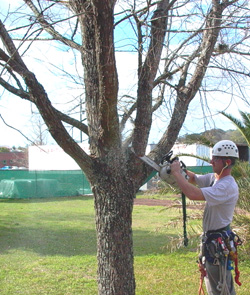Pruning to reduce subsequent storm damage
 Structural pruning by reducing the length of or thinning weak or poorly attached branches, branches
that are overextended and too long, or the longest branches in the crown will minimize the likelihood of failure and
improve tree architecture. This strategy will minimize damage in a storm. Here is why. Shortening the largest branches reduces likelihood of tree failure by reducing the wind force on the canopy.
Structural pruning by reducing the length of or thinning weak or poorly attached branches, branches
that are overextended and too long, or the longest branches in the crown will minimize the likelihood of failure and
improve tree architecture. This strategy will minimize damage in a storm. Here is why. Shortening the largest branches reduces likelihood of tree failure by reducing the wind force on the canopy.
Reducing the canopy height using appropriate reduction cuts on trees with most of the foliage at the top of the canopy will reduce the likelihood of the tree falling in storms. But remember, reducing the size of the canopy is accomplished at the expense of tree size and the accompanying benefits. Reduction cuts may also introduce decay behind the cuts. On balance, canopy reduction may be the best choice where protection from storms is the primary objective.
Thinning the canopy on full canopied trees can also reduce wind load and likelihood of failure. However, the effects may not last as long as structural pruning or reduction.
Removing dead branches from the tree canopy will reduce the likelihood of people getting injured from falling branches. If some small dead branches (less than 1.5 inches diameter) are left in the canopy, birds such as woodpeckers may be more visible in your landscape.
Elevating the bottom portion of the canopy will increase sunlight penetration to turfgrass and other plants under the canopy. However, tree health can also decline from removing too many low branches at one time or from removing large branches. Living cells in wood on the interior of the tree can die or decay as a result of over pruning.
Elevating too much can also shift too much weight toward the edge of the canopy which can increase storm damage. To preserve tree health when elevating the canopy, consider reducing the length of large branches using reduction cuts instead of removing them entirely. Reduced major branches can often be left on the tree for a very long time, whereas major branches with small interior and lower branches removed often droop and get in the way. This requires their removal later leaving a huge pruning wound.
Because of the potential for massive decay on certain tree species, remove branches greater than about 6 to 8 inches only after all other options have been considered. Ideally, elevate the canopy by removing every other branch now and the rest of the low branches a couple years from now, if needed.
By waiting, you might find that the rest of the low branches do not need to be removed after all. When the canopy is elevated or raised, consider reducing the length of long branches in the upper canopy. This combination will help minimize likelihood of the wind catching the canopy.
Removing low branches that are close to or resting on your roof will reduce building damage. However, removing low branches generally does little to reduce storm damage since most of the moment or mechanical stress at the base of the tree results from foliage and branches positioned in the upper third of the canopy.

